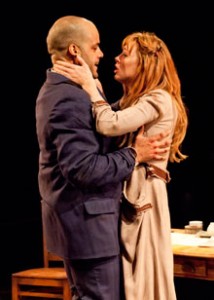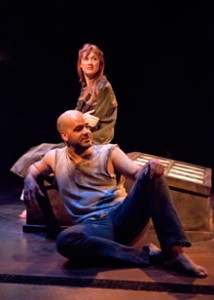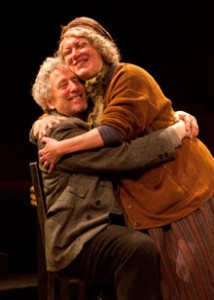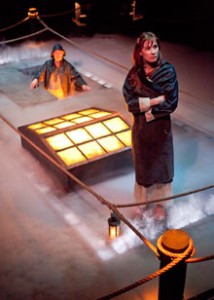NOT RECOMMENDED
There are times when a single performance can either salvage a play or sink it. In the case of The Old Globe’s revival of Eugene O’Neill’s Anna Christie, the latter is unfortunately true.
 That being said, I must confess to not getting the greatness of the Nobel and Pulitzer Prize-winning playwright.
That being said, I must confess to not getting the greatness of the Nobel and Pulitzer Prize-winning playwright.
In a recent review of O’Neill’s Desire Under The Elms, I wrote: “It’s hard to believe that O’Neill penned Desire’s often stilted dialog in the same century as Arthur Miller wrote his wholly naturalistic All My Sons.” The language O’Neill’s characters spout in Anna Christie seems to this reviewer’s ears to be not all that much more true to life, or at least to life as I’ve seen it portrayed on the stage throughout my years as a theatergoer.
Here’s one of Anna’s lines: “There ain’t nothing to forgive, anyway. It ain’t your fault, and it ain’t mine, and it ain’t his neither. We’re all poor nuts, and things happen, and we yust get mixed in wrong, that’s all.”
The “yust” in O’Neill’s script suggests that he intends his lead character to speak with a Swedish accent. The Old Globe’s Anna, New York-based actress Jessica Love, enunciates Anna’s words like someone who’s been studying in a highbrow elocution school, making them sound like line readings and no more natural coming from her lips than when Eliza Doolittle went to the Ascot Racecourse in My Fair Lady. You remember the scene. Henry Higgins has taught Eliza perfect diction, but her grammar is still that of a Cockney flower girl when she declares, “And what become of her new straw hat that should have come to me? Somebody pinched it. And what I say is: them ‘as pinched it, done her in.” Love’s delivery sounds like an Americanized version of Audrey Hepburn’s in My Fair Lady, though in Eliza’s case, there was clearly a reason for the disconnect between pronunciation and grammar, and the scene was being played for laughs.
I hesitate to place the blame entirely on the actress’s shoulders. As a recent grad of the highly selective acting program at Julliard, Love is clearly capable at the very least of dazzling a panel of judges. Therefore if the choices she makes here seem all wrong for Anna, many of them may have been made by director Daniel Goldstein.
 Still, since the title character is onstage throughout much of Anna Christie, scenes in which Anna appears sink every time the character speaks, no matter the caliber of performances surrounding her.
Still, since the title character is onstage throughout much of Anna Christie, scenes in which Anna appears sink every time the character speaks, no matter the caliber of performances surrounding her.
It’s hard to say how I’d feel about Anna Christie (The Play) had I seen its 1993 Broadway revival with Natasha Richardson in the title role, or Liv Ullmann’s performance in 1977, or Greta Garbo’s on film. Would I then have gotten the greatness of O’Neill’s tale of an ex-hooker trying for a new start in life with an Irish sailor named Mat Burke?
Opposite Love as her love interest is another East Coast actor, Austin Durant, whose performance is so absolutely terrific—big, bold, lusty, dynamic, sexy, and ocean deep—that he very nearly salvages Anna Christie. If only “very nearly” were enough.
Bill Buell plays Anna’s father Chris Christopherson with ample gusto (and a Swedish accent so thick you could cut it with a knife). It’s a performance that comes close to caricature, though doesn’t quite cross the line. Then again, each of the characters O’Neill writes is pretty much “a character” as in, “That Chris Christopherson is quite a character.”
 Kristine Nelson’s blousy Marthy is quite a character too. (The Queen of Blousy, Marie Dressler, played her on screen in 1930.) It’s another colorful performance to say the very least.
Kristine Nelson’s blousy Marthy is quite a character too. (The Queen of Blousy, Marie Dressler, played her on screen in 1930.) It’s another colorful performance to say the very least.
John Garcia and Brent Langdon do well in the supporting roles of Johnny-The-Priest and Larry. Bryan Banville, Chance Dean, and Jason Maddy are trained actors whose virtual sole purpose in The Old Globe’s Anna Christie is to facilitate scene changes.
Which leads me to Wilson Chin’s scenic design, one of two reasons (the other being Durant) that you might want to see Anna Christie at The Old Globe.
 Chin’s Act One design (a seedy bar) seems fairly simple and straightforward, tables and chairs scattered about the Sheryl and Harvey White Theatre’s in-the-round stage and two ropes hanging from rafters to floor to suggest a door leading to a separate room. Then comes the magic as before our very eyes, and with the aid of the abovementioned cameo players, the bar is transformed into the deck of a fishing scow, the entire stage area bathed in fog throughout the entire second half of Act One, as shown in the above photo. Trust me. You’ve never seen anything like it.
Chin’s Act One design (a seedy bar) seems fairly simple and straightforward, tables and chairs scattered about the Sheryl and Harvey White Theatre’s in-the-round stage and two ropes hanging from rafters to floor to suggest a door leading to a separate room. Then comes the magic as before our very eyes, and with the aid of the abovementioned cameo players, the bar is transformed into the deck of a fishing scow, the entire stage area bathed in fog throughout the entire second half of Act One, as shown in the above photo. Trust me. You’ve never seen anything like it.
Other design elements are topnotch creations as well—Austin R. Smith’s striking lighting design, Paul Peterson’s vivid sound design, Chris Miller’s moody original music, and Denitsa Bliznakova’s mostly grungy 1910 costumes. Jan Gist vocal and dialect coaching has insured some fairly realistic accents, particularly Durant’s, but what’s up with Anna Christie’s? And what’s up with those very 2012 hair extensions she’s wearing, as anachronistic as director Goldstein’s misguided choice of Joni Mitchell’s “Blue” to underscore Anna’s blues.
Casting is by Calleri Casting. Annette Yé is stage manager.
I’m seeing a production of Long Day’s Journey Into Night later this week. Let’s see if it can make me more of a Eugene O’Neill fan than The Old Globe’s Anna Christie has.
Old Globe Sheryl and Harvey White Theatre, Balboa Park, San Diego.
www.oldglobe.org
–Steven Stanley
March 18, 2012
Photos: Henry DiRocco


 Since 2007, Steven Stanley's StageSceneLA.com has spotlighted the best in Southern California theater via reviews, interviews, and its annual StageSceneLA Scenies.
Since 2007, Steven Stanley's StageSceneLA.com has spotlighted the best in Southern California theater via reviews, interviews, and its annual StageSceneLA Scenies.







 COPYRIGHT 2025 STEVEN STANLEY :: DESIGN BY
COPYRIGHT 2025 STEVEN STANLEY :: DESIGN BY